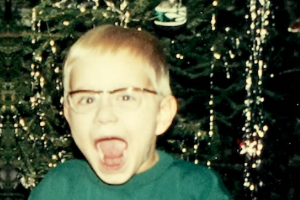The Cathedral Communications Committee has invited members of the congregation to share their Christmas memories. Below is a story from Andreas Decken.
I grew up in Germany, near the border with the Netherlands. The Christmas season started on December 6th. In neighbouring Holland, the 6th is similar to Dec 25th in Canada, when gifts are exchanged. Where I grew up, kids put their polished winter boots in the hallway the night before, and Sankt Nikolas (Santa) would either leave chocolates or bare twigs from trees in the boots. You can guess who received bare twigs.
There were many outdoor Christmas markets. People sold handcrafted gifts, but there were, of course, many booths with food and the traditional “Glühwein”, spiced wine that is served hot.
Christmas was celebrated on the eve of Christmas, “Heiligabend”. On that day, children were not allowed in the living room so that they wouldn’t disturb the “Christkind” (Christ child), who was decorating the tree. The Christmas tree originates from western Germany, a tradition that goes back hundreds of years. Once it was dark outside, the Christmas tree was lit, originally with candles but later with electric lights. After re-citing Christmas poems and singing carols, I was allowed to open my gifts.
Later on Christmas Eve, we attended the Christmas service. After the service, we congregated in the market square. A large bonfire was burning, and the church trombone choir played carols late into the night.
When I got older, I was a member of the YMCA. In Germany, the YMCA is closely connected to the Protestant church, and we would have a birthday party for baby Jesus at Christmas. The young people in their teens and twenties attended this party on Christmas Eve.
Many other German traditions are quite different from here in Canada. Did you know that the German Santa lives in the clouds? Every time it snows, it is Frau Holle (his wife) shaking out the bedding. Sankt Nikolas comes on foot from the forest, and he is not dressed in red and white. He carries a large sack with the gifts for the Christkind to place under the tree.
Other German traditions include lighting the advent wreath which has four red candles; placing nutcrackers in the house; opening the advent calendar; doing lots of Christmas baking including Stollen, the German fruitcake; and of course, lighting the candles of the Christmas Pyramid. The Christmas Pyramid is a hand-carved nativity scene placed on a multi-tier carousel that spins due to propellers that are driven by the heat of the candles.
When I came to Canada, I realized that I knew quite a few of the popular Christmas carols, since they were translated from German into English. While it was composed in Austria, the most famous German language carol is likely “Stille Nacht, Heilige Nacht” (Silent Night, Holy Night). Even today, I cannot resist singing it in German when it is sung as one of the hymns in our Cathedral Christmas services.
Fröhliche Weihnachten! Merry Christmas!

